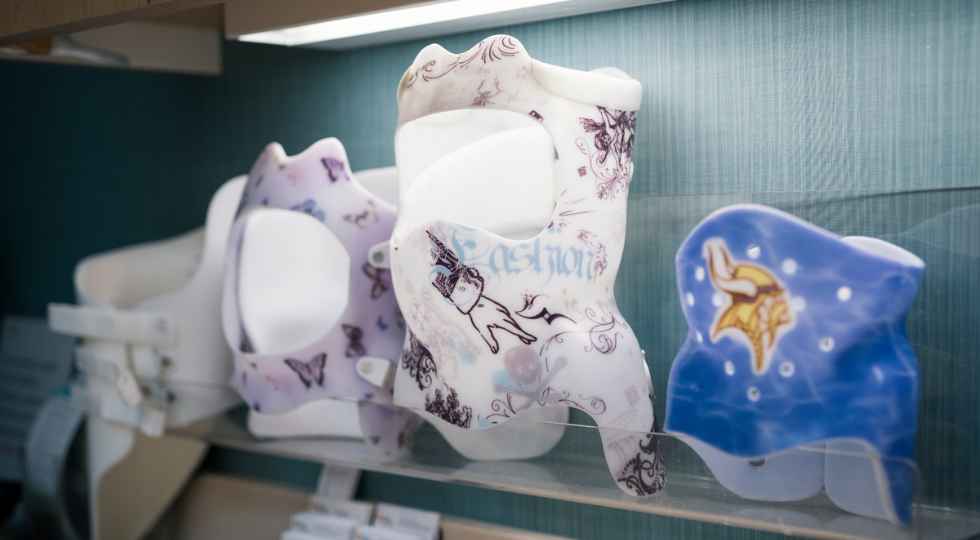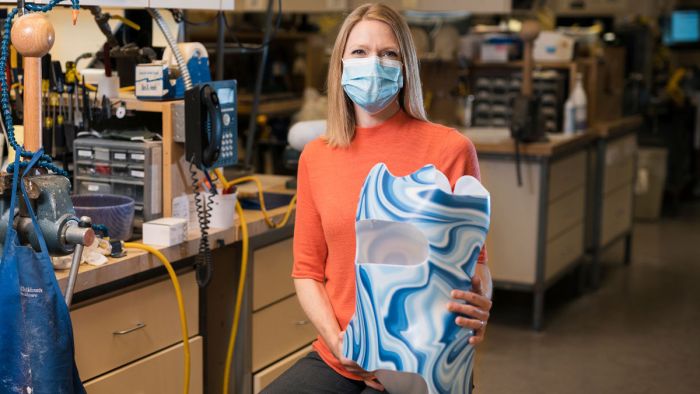While not every child who has scoliosis will require a brace, for children whose spinal curvature exceeds 25 degrees, a brace is often employed in the hopes of staving off surgery. Designing a brace can be a time-intensive process, so we thought it’d be helpful to have a conversation with a member of Gillette’s Orthotics, Prosthetics and Seating (OPS) team about how braces for scoliosis are designed and made at Gillette.
Kristin Smith, CO, is the lead orthotist of the OPS spinal orthotics team, and has worked at Gillette for nearly 20 years. When it comes to scoliosis, her relationship with the condition is both professional, as well as deeply personal. Read our conversation with Kristin below.
First off, can you talk a little bit about what you do at Gillette, and how OPS works with our Spine team?
When a patient has gotten a diagnosis of scoliosis, there’s usually a monitoring period that occurs with our spinal surgeons to gauge the progression of the condition. Once it’s been determined that a patient is in need of a brace, that’s typically going to be the first time a patient will meet us in OPS.
There’s no one-size-fits-all or standard stock brace that can adequately treat the condition. Every scoliosis brace that we make at Gillette is specifically designed for the individual patient in order to best control their unique curvature.
How do you design the braces?

That really depends upon the patient’s curve type and what type of brace they are getting.
The first step is to capture the patient’s shape and we can either use plaster to make an exact model of the patient’s torso, or we have newer technology where we can take a digital scan of the patient’s body and send that information to what’s called a 7-axis robotic arm, that can carve a replica of the patient’s torso out of foam. It’s a relatively new technique and one we’re pretty excited about. There are some patients that we can better capture their anatomy by physically using the plaster, so it’s really a judgment call by the orthotist as to which method is used and every case is a bit different. Once we get the mold or the scan, then we work to shape and design the plastic brace to best treat the patient’s curves.
The patient will then come back to see us for the fitting of their brace. We work hard to make the braces comfortable for the patient so they’ll wear it as their doctor has prescribed. As the patients grow over the course of their treatment, they need a lot of adjustments and we end up spending a lot of time with the kids and their families. That continuity is one of my favorite aspects of my job.
I still get Christmas cards and updates from many of the families I’ve worked with over the years, and I can’t tell you how gratifying it is to see our kids out in the world living their lives following treatment.
Generally, how many hours a day do the braces need to be worn to be effective?
The amount of time that patients wear their braces depends upon their curve and how much growing they have left. For a patient who has a curve that is at a high risk of progressing, they are prescribed a full-time brace and it’s supposed to be worn for 18-20 hours per day. For patients who present with less risky curves or who are close to being finished growing, they may be prescribed a nighttime brace, which is only worn when they are sleeping.
No matter which brace a patient gets, if they can wear their brace as their doctor or provider has prescribed, they have the best chances of stopping their curve from getting worse. It can be really difficult for a teenager to wear their brace, especially those who need to wear it to school, but many of our patients and families are extremely dedicated to wearing their brace, and I always tell them when they complete their treatment that they should be incredibly proud of themselves.
It’s no small thing to ask a kid to wear a back brace for years. It’s really an awesome personal achievement!
How did you get into your line of work?
When I was a teenager, I myself was diagnosed with scoliosis. I was actually treated at Gillette with a brace and eventually, a spinal fusion. To be honest, like many kids I hated wearing my brace, but I really liked my doctor and my orthotist who treated me and thought it would be a pretty cool profession to go into.
I don’t think I would’ve found out about the field if I hadn’t had scoliosis myself. I worked as an orthotic technician making braces in the OPS lab while I was going to college and then was hired on after my residency. I guess I just never wanted to leave!
Does the fact that you've had scoliosis give you a greater understanding of what your patients might be going through, and is it something you share with them?
You know, earlier on in my career that’s something I did a lot of, but now that I’m getting closer to 40, I don’t always know if the younger patients I’m treating want to hear that from me (laughs).
While having scoliosis does give me a window into what our patients might be going through, it’s good to remember that whether a child has scoliosis, cerebral palsy or any of the other conditions we treat at Gillette, each child experiences their condition differently. Sure, there are often similarities that you pick up on over time, but each child is their own unique individual, so I’m careful to not make too many assumptions. That said, I do think that having gone through scoliosis treatment myself, may give me a little more credibility for some of my patients.
Not every medical facility has OPS staff onsite, do you think that your team being physically located in the same place as our spine team makes the care provided better and more efficient for patients and families?
Oh, certainly. The work that we do is very collaborative, and I think it’s a tremendous comfort for families to know that their provider and their orthotist work together to provide the best brace that we can. If a patient is having issues with their brace, they can come right down the hall to see us for some tweaks to make the brace fit better.
That’s definitely a unique aspect of the care we provide at Gillette and not something that would be possible if the OPS lab was off-site.
Are there any resources you typically recommend to patients who’ve recently received a diagnosis of scoliosis?
We have some excellent patient education resources internally and on our website, but seeing that scoliosis is a condition that predominately occurs in girls, sometimes I’ll encourage my patients to reach out to Curvy Girls.
Curvy Girls is a peer-led counseling group for patients who have scoliosis. They have monthly meetings in the Twin Cities metro and are having them online during COVID. The meetings give patients and families dealing with scoliosis an opportunity to connect and discuss their experiences with the condition. Much in the same way I hope that my own experiences with scoliosis are a comfort to the patients I treat, I think it can be very helpful for children who have received a diagnosis to connect with one another. The diagnosis of scoliosis can be traumatic and scary, and it’s easy to feel like it’s just happening to you when you’re going through it.
Curvy Girls gives patients the opportunity to talk to other kids who are going through similar things, and really reinforces the idea that they’re not alone.
 Home Page
Home Page

